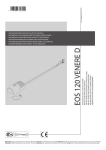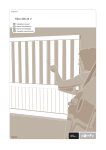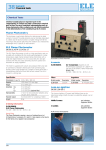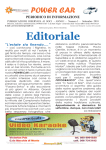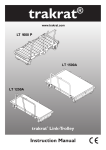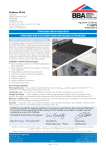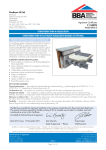Download PREVIEW VERSION
Transcript
DALEK W E I V E R P Version 6.0 , May 2006 Preview sample only N O I S R E V BUILDERS This document is subject to copyright. Unauthorised sale and distribution, in any format, is strictly prohibited. WORKSHOP MANUAL www.projectdalek.co.uk www.forum.projectdalek.co.uk www.projectdalek.co.uk 2 PREVIEW VERSION WANT TO BUILD A DALEK? Contents... Well, here’s how... These guidelines are intended to give newcomers a general idea of what materials and techniques are required when building a full size Dalek, using any of the plans currently available from Project Dalek. The bulk of the measurements are given in imperial sizes. This is because Daleks were originally designed using feet and inches and these measurements often don’t translate well into centimetres. You will find that the plans booklets for the 1960’s Daleks (both TV and movie) are presented in inches, whereas the plans for the 2005 Series Daleks are in centimetres. Centimetres have been used on the modern Dalek plans as they are most likely to have been used during construction of the new props. For many years the most popular plans were the ones published in the ‘Radio Times’ back in 1973. While these are a good starting point, they are often inaccurate and should be used with caution. Building Daleks is a serious business and there are many issues to consider. Before you jump right in and start building, it is important to do plenty of background research. We all have our favourite Dalek story and more often than not, wish to create our Dalek to that specification and colour scheme. Memory tends to play tricks, so try and find as many pictures of ‘your’ Dalek type as you possibly can. This will give you a good idea of what build variations you need to watch out for. If you haven’t already, please join the Project Dalek Forum (see page 2 for the web-site address). You will be able to obtain the plans shown below as well as lots of help and information. Our members will be only too happy to try and help if you get stuck! When building a Dalek it is best to break it into sections. Construction will be covered one section at a time, starting at the top and working down... Section 1 . . . . . . . . . . . . . . . . . . . . . .Dome, page 6 Section 2 . . . . . . . . . . . . . . . . . . . . . . .Neck, page 8 Section 3 . . . . . . . . . . . . . . .Shoulders, page 10 Section 4 . . . . . . . . . . . . . . . . . . . . . . .Skirt, page 14 Section 5 . . . . . . . . . . . . . . . . . . . . . . . .Base, page 16 Section 6 . . . . . . . . . . .Appendages, page 18 Section 7 . . . . . . . . . .Finishing Off, page 23 Section 8 . . . . . . . . . . . . . . . . .Painting , page 25 Section 9 . . . .Ring Modulators , page 26 Section 10 . . . . . . . . . . . . .Advanced , page 27 Section 11 . . . . . . . Colour Guide , page 32 7 5 11 12 Essential tools... 19 14 18 20 22 1. 2. 3. 4. 5. 6. 7. 8. Dome Dome lights Eye cowl eye-stalk Eye disks Eyeball Iris Neck Mesh 9. 10. 11. 12. 13. 14. 15. 16. Neck struts Neck rings Neck blocks Shoulders Shoulder mesh Slats Gun box Ball joints 17. 18. 19. 20. 21. 22. 23. 24. Gun Plunger & arm Claw Collars Skirt Hemispheres Base Fender What flavour Dalek should I build? D aleks changed throughout their BBC (and film) history. Some of the obvious changes are the adoption and subsequent removal of large fender bases and “antenna” dishes. The variations range from these major changes to smaller, more subtle alterations such as the number of disks used on the eye-stalk. This document isn’t about comprehensively listing these changes, it is simply here to help you with the mechanics of putting the thing together, it is up to you, dear builder, to do your homework. Having said that, here is a top ten of popular Dalek variations to get you started... Top Ten 1. The whole Dalek: The Imperial Daleks in ‘Remembrance of the Daleks’ are of an entirely different ‘build’. They are slightly narrower and have their collars moulded into the shoulders. The Daleks from the 2005 series have totally different shoulders, along with a host of other differences. Never use professional spray paints without the recommended safety gear. Some paints are useable with masks whereas others, particularly two pack paints, require specialist breathing equipment. Misuse of these paints can kill - so please, be careful! Circular saw, scroll saw, band saw, router, electric bench drill press, electric sander, electric cordless screwdriver, hot glue gun, staple gun. 3. Shoulder slats: Early Daleks (TV and first film) do not have mesh or slats around their shoulders, just simple collars. 4 PREVIEW VERSION 17 24 Recommended tools.... Remember, losing your patience is only one step away from losing your fingers... 13 23 2. The base: Film Daleks and TV Daleks in ‘Invasion Earth’ have larger ‘fender’ style bases. Also, standard bases tended to get taller in later Dalek stories. Air compressor, radial arm saw, vacuum forming table, welding equipment, sheet metal guillotine. 16 15 Jigsaw, electric drill, hacksaw, hammer, chisel, mallet, screw drivers, tenon saw, files, assorted clamps, workbench/vice, hole cutting set. Luxury items (I wish I had) .... 1 8 10 Dalek building requires a varied number of tools and materials. It is essential that the manufacturer’s instructions are always followed. Protective clothing, masks and goggles should always be used when there is any danger of injury. Also, some of the materials, particularly fibreglass should be used in well ventilated areas. Keep stray family members and pets well away from materials and situations which may cause them harm. If things aren’t going to plan put down the chainsaw (or whatever you are using) and go and have a nice cup of tea. Problems are often easier to overcome after a short break. 4 6 2 9 21 Don’t feel that you have to follow these instructions to the letter, improvise and if you can think of better ways of doing something, or you have other materials that are suitable, use them. Remember, above all, Dalek building should be fun. SAFETY 3 Materials for each section are listed within that section in order to keep things simple. It is recommended that readers should familiarise themselves with the construction methods listed in all sections before starting to build their Dalek. Some builders may consider the fibreglass construction of the dome a little daunting as the first step in Dalek building. In this case, start with an easier section. Pick a section that you feel comfortable with, given your expertise and the tools/materials to hand. Once you have made a good job of one of the easier sections you will feel more confident at attempting something a little more adventurous. Above: The plans currently available from Project Dalek. So which bit is that, then...? 4. eye-stalks: These vary dramatically throughout the whole of Dalek history. Film ones are often longer than TV ones and the number of disks and the design of the iris changes too. 5. Dome lights: Bulbs, drinking beakers, egg-cups and beehive style car lights have all been used. 6. Gun: Larger bore on film Daleks and sporting octagonal ‘mantles’ on early TV Daleks - not to mention special ‘projectile weapons’ guns used in the 1970’s. For the latest Daleks, the gun has become angled and chunky. 8. Neck struts: They have a “clover leaf” cross section on early Daleks but simplify into straight round struts on later Daleks.They develop corners and little blocks on the 2005 design! 9. Plunger arm: Any number of different plunger sizes and shapes plus the addition of ‘claws’ on some film Daleks. Also, the number of telescopic tubes changes from three to two on some later Daleks. 10. Gun box design: Some gun boxes slope backwards, some are level. Later ones have an oval plate between the two ball joint holes. 5 PREVIEW VERSION The Skirt, Part 3, Panels... Sitting down... Skirt panels should be made from thin wooden sheet, 4mm MDF is ideal, though hardboard or other materials could be used. Try to avoid wood that has a grain as this will be difficult to hide when painting the skirt later on. If your plans give individual panel dimensions, use these but double check before cutting. If you don’t have a set of pre-defined panel shapes, don’t panic, proceed as follows... Some would say that the whole point of having a Dalek is to get inside it and threaten lesser mortals with imminent extermination. This is best done from a seated position, so you must add a seat to the inside of the skirt. Working one panel at a time, cut out a slightly over size rectangle then lie it against the skirt frame so that it covers the whole area that the final panel will cover. Clamp it into place, then, using a pencil and ruler, draw lines on the back of the rectangle starting at the top corners of the frame and ending at the lower corners. Repeat this for the horizontal lines so the final shape of the panel is marked out on it’s rear. Cut the panel and test fit it. Remember the sides of each panel will need to be cut with, or sanded to, an angle or cut in order for the next panel to butt up to it snugly. It is recommended that you only fit a panel when you can offer up each adjacent panel to check the way they fit together. The front two panels have a distinct twist according to most plans, including those available from Project Dalek - don’t panic, this is normal. Depending on the plans you are following, other panels may have a slight twist too. Secure the panels with wood glue and panel pins (punch in the heads so they can be hidden with filler). When all the panels are fitted, run strips of fibreglass up the inside panel joints and around the top and bottom where the panels meet the frame. This will stop the panels moving around and add great strength. Fill up any exterior imperfections with car body filler. If you are fitting the hemispheres from inside you must mark out and cut the holes (see plans for positioning). Use a drill with a hole cutting attachment and remember that the lower shoulder collar fits over the skirt by approximately half an inch so take this into account when positioning the top row of holes. If you are fitting the hemispheres from the outside (a must for 2005 Series Daleks which include a black ring around the base of each hemisphere), you must mark out the centre positions and drill the holes through which the fixing bolts will be fitted later on. Prime the finished skirt with at least three coats of primer and then sand using the methods detailed under shoulder construction (Section 3). Four vertical timber struts should be run from the top of the frame to the bottom and be firmly secured. These are positioned near the rear of the Dalek, leaving enough clear space to insert hemispheres if needed. Now work out the height that you want the seat to come to. Sit on an adjustable office type chair and move it up and down until your feet can wheel it around the room (we’ve all done that before, haven’t we). This is the height that your seat should be set to. Cut four further timber struts to this length and drill/bolt them to the sides of the other struts you just fitted so that a seat base can be slid in on top of them (round edged kitchen worktop is ideal). Secure the seat base to the long uprights with right angled brackets. If you are adding a separate base section, it may be worth considering the attachment of the seat to this, rather than the skirt. Be sure to take the additional height of the base into account when setting the seat height. Section 5: The Base... The 2005 series Dalek base As mentioned in the previous section, you have a choice of how to make the base. You can either make it as a separate unit or build the skirt up onto it. If you intend to do this you may wish to consider splitting the base/skirt for ease of transportation. In either case, the base should first be made up as one section and then cut, if necessary, once completed. A cut base can be joined back together and the two skirt halves built on top in the usual way (refer to Section 4). The large fender bases used on Movie Daleks/MK2 Daleks and the base section on the 2005 series design are not suitable for splitting. These bases should be constructed as complete units, bolted to the skirt once both sections are complete. For a standard Dalek base you will need a large piece of 18mm MDF for the main base structure. The perimeter should be marked out and cut using a jigsaw. Remember, measure twice, cut once. You will also need an ‘inner’ hole cutting, through which your feet can go in order to propel the Dalek into unsuspecting crowds. When deciding on the size of the inner hole, consider the positioning of the wheels and the seat frame - you need enough board left over to accommodate these essentials. If in doubt, leave the inner hole until last, when the wheels and skirt are in place. Using further strips of 18mm MDF, double up the depth of the base edge by attaching a layer of strips to its underside. This will give you 36mm which should be enough to attach the rubber to. If you wish to build a Dalek with a further, rebated underside, like the imperial kind, add a second layer of wood to the desired thickness, stepped in from the previous layer. Movie fender bases are more difficult to construct due to their curved edges. The top of the fender should be made first from MDF/ply using a jigsaw to cut out the basic shape. The curved edges can be made by building up layers of wood underneath the top section. These should be glued and screwed together. Once the basic shape has been achieved, the curved edges can be made by sanding back the built up areas using an electric sander. The sides of the fender can then be made from either wood or rubber sheeting, depending on which style of Movie Dalek you are making. 16 PREVIEW VERSION 2. Locate: The Plunger Arm... The plunger arm is made from two or three lengths of aluminium tube. The quantity depends on which era of Dalek you are building, do your research and refer to your chosen set of plans. The tubes are different diameters and are therefore able to slide together creating the desired telescopic effect. First of all cut the tubes to the correct lengths and then tidy up the cut surfaces. You now need to ‘bush’ the tubes so that they don’t rattle or fall apart when extended. This is done by adding layers of PVC insulating tape to either the inner, or outer surfaces, depending on the tube (see illustration). When the tubes are assembled a plastic ‘cap’ should be added to the end of the large tube (cut a hole in it’s centre for the pole to pass through). Any suitably sized bottle cap will do (a good tight fit is desirable). This stops the inner tubes from pulling out backwards. Further bushing may be required where the tubes connect, depending on the style of Dalek. Small ‘washer’ shaped disks made from wood, plastic or metal are ideal for this. Bush, outer edge of 2nd tube. Inner wooden pole. Bush, inner edge of 2nd tube. Shopping list... 3x (2x on some Daleks) different thicknesses of aluminium tube - see your plans for exact specification. Wooden pole. PVC tape. P40 car body filler. Can of expanding foam filler. A plunger (preferably a hemisphere, not ‘bell’ shaped). Plunger screwed to inner pole. P40 ball joint Plastic end cap. Bush, outer edge of 3rd tube. Bush, inner edge of 3rd tube. The inner most tube needs a wooden dowel threading through it, which extends a little further than the back of the outer tube when the arm is fully extended - enough to provide a control handle. The outer end of the wooden pole provides a good surface on to which the plunger can be screwed. This also prohibits the inner tube from being fully pulled through the outer tube when the arm is retracted. If available, a longer length of aluminium tube may also be used. In this case, take care with the measurements when cutting the thinnest tube. The end of the tube can be plugged with a wooden insert or a nut can be glued into position, ready to attach the plunger. To make the ball joint, follow the instructions in Section 4 on building a hemisphere from P40 car body filler. You will need two of these to make the ball joint. Glue them together using epoxy resin and then fill and sand to a fine finish. Drill a small pilot hole all the way through the ball from front to back and then increase the size until the outer arm tube can be threaded through. Position and fix into place with epoxy resin. Drill a small hole in the back half of the ball joint and use it to fill the ball with expanding foam filler. Once dry, seal the hole with car body filler or epoxy putty (Milliput). Prime and paint the ball joint with the appropriate colour. Thread the arm into the Dalek from the inside and attach the plunger to the end. If you are lucky, you may be able to track down some 4” (hollow) steel or aluminium spheres. These are ideal as ball joints but drilling the holes for the tubes can be tricky. Wrap the sphere in masking tape to protect it, then clamp it firmly in a drill press before attempting to cut the holes. Run the drill on a slow speed using a metal cutting hole saw. Cool the surface with oil as you gradually cut through. Make sure you get both holes lined up or your arm will be wonky! The 2005 series plunger is a far more complicated assembly. In order to create it you will have to use a hemisphere made from a stiffer material (not rubber). The various detail parts can be cut from flexible plastic or card, glued on to the inside and outside surfaces. The disks to the rear of the plunger (and the plungers rim) can be made from wood or plastic, glued into position. The completed ‘sucker’ should then be filled, sanded and painted black. Note that this style of plunger has detailing on both the inside and outside of the suction cup. Wave it about... What you put on the end of your Dalek’s arm will depend on which style of Dalek you are building. Most Daleks have a standard plunger attachment while some Movie Daleks have a claw. Other ‘specialist’ arms have also been used from time to time, including a cutting torch and cutting claw. Do your Dalek homework to find out more about these custom attachments. Although the plunger is the simplest solution, modern plungers are often the wrong shape (bell shaped). You may have to hunt around the shops to find one with a reasonable shape and diameter. If you have an original plunger from the 1960s or 1970s, let me know! The Movie Dalek claw can be made quite easily from MDF. Cut the two basic sections out with a jigsaw and then sand them to a smooth finish. In order to make both sections identical, clamp them together, one over the top of the other, when sanding the edges. The rest of the mechanism can be made from off-cuts of steel or aluminium fixed with couple of pivot bolts. A working claw can be produced with a little extra effort by adding two flat springs to the rear of the central pivots. these push the claw into the open position. Pulling back a central rod (inside the arm) closes the claw. 20 PREVIEW VERSION Section 10: Advanced Dalek Building... Motivation... This section covers the aspects of Dalek building which you may wish to considers after you have gained a little experience. Later we’ll take an in-depth look at fibreglassing techniques. First, lets look at motorising the Dalek by adding the running gear from an electric wheelchair... Daleks are fun to play around in but after a while they can make your leg muscles cry for mercy. It’s at this point that many Dalek builders look for salvation in the form of ... motorisation. Part 1: Motorisation. An ideal source of the parts you need to motorise a Dalek can be found on that ‘robot wars’ favourite, the electric wheelchair. What bits do I need? Purchasing a complete second hand chair is by far the best option when looking for the parts you require. A complete chair is guaranteed to have all the parts and, if the batteries are good, it can be seen running before you part with your hard earned cash. Second hand chairs with ‘good’ batteries are few and far between. The batteries are so often degraded due to either age of lack of charging/use. Whatever price the chair is, always budget for new batteries. If the batteries with the chair turn out to be serviceable, so much the better. I’ve got my chair, now what? It is possible to actually fit a whole chair assembly into a Dalek. This is best done when you are building the Dalek ‘around’ the chair as opposed to ‘retro-fitting’ an existing Dalek. This has been done successfully but it is not easy and can cause headaches when trying to find suitable mounting points for the base/skirt section. If you are aiming to just build around the chair, then its basically a case of using whatever mounting opportunities your chair has to fix the Dalek in position. Remember that all that metal work does add weight to the finished article, so if anything can be removed (steps, leg plate etc), then remove it. Most Dalek builders will opt to strip the chair down completely and just use the electrical items. This makes it easier to build a chassis for ‘new’ Daleks and is absolutely essential when retro fitting into an existing Dalek. Note: It is next to impossible to ‘retrofit’ a full working wheelchair into an existing Dalek. Battery box. Joystick unit. Control box(es). Drive wheels. Motors/gearboxes Front wheels. Make a note of which plugs go in which sockets as you disassemble the parts - get these connected up wrong, later on and you could end up going backwards (or in circles). Under normal circumstances it shouldn’t be necessary to disconnect the wheels from the motors, however some chairs have small brackets for kerb lifting etc which are mounted between the motors and the wheels. Removal of these can sometimes mean that the wheels have to come off in order to access the fixing bolts. If you are lucky enough to have the user manual for your power chair, there is usually information on wheel removal and replacement contained therein. If you are working blind then you may have to poke around to find out how the wheels are fixed in place. Those electric buggies that you often see in the streets (and in supermarkets) are less than ideal for Dalek use. This is because of the method used for steering the vehicle, which is usually done by turning the front wheels via handle bars. This sort of setup is going to make a Dalek difficult to manoeuvre and also tie up both of the operators hands. An electric wheelchair is usually controlled by one small joystick. The steering is achieved by the rear drive wheels being turned at different speeds. For example, when the joystick is pushed left, the right hand wheel turns faster than the left and wheel, causing the chair to turn in the desired direction. Smooth mould interior surface Separated flange A similar technique should be used on the larger sections, introducing small wedges in the problem areas until the sections separate. If all else fails, try introducing water into the wedged gaps, this will dissolve the release agent and help the releasing process. Warm water is best as it will work quickly and cause expansion of the parts. Once your mould sections are released, you can trim away any excess matting from around the flanges and generally tidy up the edges. Use a jigsaw (with a metal cutting blade) to trim the fibreglass and a surform or wet and dry sandpaper (used wet) to smooth over sharp corners. Always wear a mask when performing these activities. Rough interior surface The skirt mould sections after separation from the plug. The mould sections should be thoroughly washed and dried before any attempt is made to use them. They can then be bolted together (where required) and thoroughly waxed. The process for producing the final parts is exactly the same as for producing the moulds. Refer back to the beginning of this section for the required information. The only minor difference is in the thickness of the laminate and gel-coat, they needn’t be as thick on the final Dalek sections. Section 11: Colour and detail quick reference guide... This has the additional advantage of allowing the chair (Dalek) to be able to turn around almost ‘on the spot’ without needing forward motion to help with the turn - an effect that is ideal for genuine Dalek manoeuvres! Power chairs come in several different makes, shapes and sizes. The most modern chairs will run of 24v DC electrics. These 24v motors are the kind you need for adding motive power to your Dalek. In general terms, the bigger the motors, the better. Story: The Daleks (a.k.a. The Dead Planet/The Mutants) Story: The Dalek Invasion of Earth Story: The Dalek Invasion of Earth Silver and bare aluminium with a grey shoulder section. Note the lack of slats and mesh plus the number of eye discs. Slight detail changes including a choice of black or silver eye-ball and the addition of larger bases and a rear dish. This is the ‘Saucer Commander’ complete with alternate black and silver panels and a black dome. Story: The Dalek Invasion of Earth Story: The Chase Story: The Chase The Dalek Supreme with black dome, shoulders and skirt. Original dome lights and gun ‘mantles’ are still in situ. The first story to see the appearance of mesh and slats. Also the first appearance of ‘egg cup’ style dome lights. The Dalek Supreme regained his grey shoulders. A darker blue was also used for the hemis’ from this story onwards. Story: Mission to the Unknown (a.k.a. Dalek Cutaway) Story: Mission to the Unknown (a.k.a. Dalek Cutaway) Story: The Daleks’ Master Plan Silver Dalek as per ‘The Chase’ complete with three part plunger arm which remained until the 1970s. The Dalek supreme wasn’t updated from his “Chase” livery and like all previous Daleks, had a blank stare with no pupil. Standard silver and grey Dalek. In some scenes the plunger arm was replaced with a pyroflame arm or seismic detector. Most power chairs which are designed to carry adults will happily pull along an average size human in an average weight Dalek. Some of this depends on how heavy your Dalek is. If you have already built a Dalek and made it out of heavyweight materials, you may cause the motors to struggle. If you are scratch building the Dalek onto a motor assembly it is worth bearing the weight aspect in mind, choosing materials carefully. Bits to keep... The usual method of wheel attachment uses a large nut and a ‘lock washer’ which stops the nut from unscrewing as the wheels turn. These are normally hidden behind plastic (or rubber) covers at the hub of each wheel. Remove the covers and asses the method by which the wheels are attached. If you find a nut and locking tab assembly proceed as follows... Motors complete with gearboxes, wiring and wheels. Control box. Use a screwdriver to lever the ‘closed’ locking tabs away from the nut so that the nut will be free to turn. A locking washer will usually have an arm bent up over one of the ‘flats’ of the nut and one bent in the opposite direction, gripping a recess in the gearbox body. Battery boxes. 27 PREVIEW VERSION If this is not enough to prize the sections apart, you will need to use small wooden wedges. The wooden stirring sticks you can buy from automotive paint suppliers are ideal for this. In the case of the dome, a stick can be introduced between the mould and the plug (or mould and final dome) and then gently tapped until it curves around the chamfer, all the way to the top of the dome. The wood is thin enough and here is enough flexibility to allow it to do this. On most occasions the two sections will separate. If this does not happen, introduce a second wedge at the other side. This will almost certainly lever the two sections apart. Joystick box. Seating upholstery. Associated cables. 32 PREVIEW VERSION The author’s Dalek, created using the techniques detailed within this guide. I hope this guide has been of some use to you, and I wish you many happy hours of Dalek building. Remember, be careful, stay safe, and always know where your hands are in relation to that blade! John Darley This guide has been produced for anyone wanting to build a Dalek for their own personal use. It is not this guide’s intention to encourage any commercial activity regarding the selling of Daleks. The Dalek name and image © B.B.C./Terry Nation 1963. At the time of writing, the BBC copyright for the licensing and selling of the full size Dalek form is held by This Planet Earth Ltd., Crewe, Cheshire. This document © 2006 John Darley. All rights reserved. 35 PREVIEW VERSION W E I V E PR N O I S R E V






